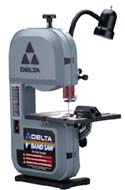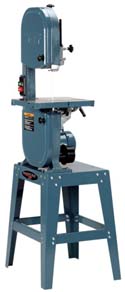band saw
A band saw is a type of power saw used in woodworking, metal working, and working with a variety of other materials. It consists of a narrow, toothed, metal band that is coupled to and driven continuously around the circumferences of two wheels. The band rides in the same vertical plane as the wheels, which have a space between them.
Band saws are especially useful for cutting irregular shapes. The radius of a curve that can be cut on a particular saw is determined by the width of the band: the narrower the band, the tighter the curve.
Band saws can also handle thicker stock than most table saws or radial arm saws, and can cut thin veneers effectively.
Their only disadvantage is that they require more a lot of set up. Different operations call for different blades and each time a blade is changed the saw has to be tuned to that particular blade. Professional workshops usually end up with a large machine for heavy work and a smaller machine with a narrower blade for fine work.
Bench-top band saws
These can be mounted directly on a workbench or on their own stands. Their compact size makes them suitable for small workhops and light scroll cutting.
 |
| Bench-top band saw
|
Floor-model band saws
These are usually more stable and more powerful than bench-top saws. The combination of increased stability and power make them especially useful for heavy rip sawing and decorative work on thick stock.
 |
| Floor-standing band saw
|
Specifications
Horsepower: the maximum power produced by the motor. Saws with high horsepower ratings are good for pattern cutting and cutting down thick stock. Higher horsepower also allows the saw to cut through thick stock without bogging down or burning the wood.
Throat capacity: the distance between the saw's blade and the frame. This ranges from 8" to 36". The size of the throat determines the maximum width of the saw's cutting capacity. Saws with wide throats allow you to make wider straight cuts and scroll larger pieces without the frame getting in the way. Choose at least a 14" model if you plan to do much resawing as the smaller models are a bit too light.
Blade width. Most saws accept narrow 1/8" blades for cutting detailed designs and tight curves. Better saws also accept wider blades, up to 1". Wide blades don't flex as much as narrow ones, but they make accurate straight cuts in thick stock quicker. There are also some wide blades available that can cut metal.
Band saw blades
Band saw blades are classified by width, number of teeth per inch (tpi), rank angle, and material composition. When selecting a blade, remember to match the blade width to the type of cutting you are doing.
· Narrow blades can make cuts of smaller radius but tend to twist and wander when making long straight cuts.
· Wide blades can't make turns as tight as those of narrow blades but hold a straighter line.
· The tpi determines the speed with which the blade cuts through stock. Blades with high tpi cut slower but leave a very smooth edge. They are best for detail work on thin stock. Blades with low tpi cut quickly and leave a slightly rough edge. They are suited for resawing or long rip cuts.
· Regular Tooth. Available in finer tooth pitches for smoother cuts in all woods. Not suitable for resawing.
· Hook tooth. 10° rake angle – best for hard and difficult to cut woods. High rake angle makes the blade very aggressive.
· Skip Tooth. 0° rake angle – best for softer woods. An all purpose blade, excellent for resawing.<
· Steel blades. Inexpensive and work well for cutting softwood but dull quickly in hardwood.
· Bimetal blades. Made of high-speed steel and can cut thin metal or wood.
· Carbide blades. For wood cutting only. They are more expensive than other blades but stay sharper longer than steel or high-speed steel.
